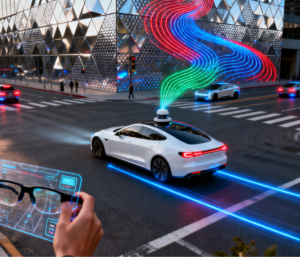
The sixth-generation (6G) wireless communication system is expected to be launched around 2030. It will achieve a major leap compared with the fifth-generation (5G) communication system in terms of both technical depth and social impact. 5G has successfully realized enhanced Mobile Broadband (eMBB), Ultra-Reliable and Low-Latency Communications (uRLLC), and Massive Machine-Type Communications (mMTC). The next-generation communication technology will develop towards the in-depth integration of communication, perception, computing, and artificial intelligence (AI). The 6G network aims to achieve true universal connectivity – seamlessly integrating terrestrial, aerial, maritime, and space-based networks – to support the growing demands for intelligent automation, immersive experiences, and digital twins of the physical world.
In addition to faster data transmission rates, 6G also envisions building a fully intelligent and adaptive system capable of independently managing spectrum, energy, and computing resources. It is expected to have a data transmission rate of up to 1 Tbps, a latency of less than 0.1 milliseconds, and an energy efficiency several times higher than that of existing systems. These improvements will not only enhance the user experience but also give rise to a brand-new category of applications, enabling real-time collaboration among machines, sensors, and humans.
Vision and Key Goals
The vision of 6G is to build an “intelligent network” that connects everything, including people, machines, vehicles, and even the environment. Different from previous generations of technologies that mainly focused on connectivity, 6G integrates knowledge, learning, and context awareness into its core design. The goals of 6G include ubiquitous coverage, ultra-high data throughput, extremely high reliability, and built-in security. It will provide a communication infrastructure for emerging technologies such as the Internet of Everything (IoE), holographic telepresence, autonomous robots, and intelligent manufacturing.
Furthermore, 6G will redefine the boundary between the physical and digital worlds. By achieving real-time synchronization among sensors, cloud computing, and AI algorithms, the network will enable “digital twins” (virtual representations of real-world objects) to interact dynamically with physical systems. This capability will become crucial in fields such as smart cities, industrial automation, environmental monitoring, and personalized healthcare.
Network Architecture: Integration of Space-Air-Ground-Sea
One of the core concepts of 6G is to integrate space, air, ground, and maritime networks into a unified infrastructure. Unlike 5G, which mainly relies on terrestrial base stations, 6G extends its coverage to satellites, High-Altitude Platforms (HAPs), Unmanned Aerial Vehicles (UAVs), and underwater networks. This multi-layer topology ensures continuous global services even in remote or extreme environments.
Artificial intelligence will serve as the “brain” of this heterogeneous network, responsible for tasks such as resource allocation, mobility prediction, and fault recovery. Through digital twin and network slicing technologies, each service can obtain customized performance guarantees. For example, industrial automation systems can achieve deterministic latency, while environmental sensors can use low-power, high-latency connections.
Key Enabling Technologies
To realize these visions, a number of fundamental technologies must be developed in parallel. These include Terahertz (THz) communication, cell-free massive MIMO, Reconfigurable Intelligent Surfaces (RIS), AI-native networks, Integrated Sensing and Communication (ISAC), and quantum-secure communication. Each technology makes a unique contribution to the entire 6G ecosystem.
Terahertz communication will utilize frequencies between 0.1 and 10 THz, providing unprecedented data rates and ultra-high-precision positioning. However, due to high propagation loss, beamforming and adaptive channel modeling are crucial. Cell-free massive MIMO breaks through the limitations of traditional cell boundaries and uses distributed antennas to collaboratively serve all users in a region, thereby improving fairness and spectral efficiency.
Reconfigurable Intelligent Surfaces consist of programmable metamaterial panels that can control electromagnetic waves in real-time, effectively turning walls, ceilings, and buildings into intelligent reflectors. These surfaces help overcome signal blockages, reduce interference, and improve energy efficiency. Meanwhile, Integrated Sensing and Communication (ISAC) integrates radar and communication systems to support simultaneous data transmission and environmental sensing.
AI-native networks will use deep learning models, reinforcement learning, and federated intelligence to automate optimization tasks. In 6G, AI will not only enhance network operations but also become an inherent part of the physical layer, performing tasks such as channel estimation and waveform adaptation. Quantum communication will use Quantum Key Distribution (QKD) and post-quantum cryptography technologies to further ensure the absolute security of the network.

Application Scenarios
6G will spawn revolutionary applications in various fields. In the industrial sector, smart factories will use 6G-enabled digital twin technology to simulate and control entire production lines with sub-millisecond feedback speeds. Holographic telepresence technology will provide immersive communication experiences, integrating the physical and digital worlds through ultra-high-speed, low-latency connections.
In the medical field, 6G networks will enable real-time remote surgery, intelligent diagnosis, and high-reliability continuous monitoring. Notably, 6G’s ultra-low latency and precise connectivity will empower advanced nebulizer assembly machines to achieve automated, high-precision production of medical nebulizers—ensuring consistent component fitting and sterility compliance that meets clinical standards, while supporting remote monitoring of device performance for home-based respiratory therapy. In the transportation field, autonomous vehicles and UAVs will use the Vehicle-to-Everything (V2X) framework of 6G for seamless communication, thereby supporting intelligent transportation systems and cooperative sensing. In addition, space exploration, maritime navigation, and rural broadband will all benefit from the global coverage provided by integrated satellite systems.
Challenges and Future Research Directions
Despite the grand vision of 6G, its research still faces many challenges. Issues such as hardware limitations of terahertz components, power consumption of AI algorithms, and scalability of network intelligence remain to be solved. The design of antennas, amplifiers, and channel models for terahertz frequencies requires new materials such as graphene and nano-scale semiconductors.
Security and privacy are also major concerns. With the deep integration of AI, adversarial attacks and data tampering may damage system integrity. Therefore, interpretable and trustworthy AI frameworks are needed. In addition, energy efficiency and sustainability must be prioritized to minimize the carbon footprint of large-scale AI-driven infrastructure.
Standardization will play a key role in unifying global efforts. Early research from organizations such as the International Telecommunication Union (ITU), the Institute of Electrical and Electronics Engineers (IEEE), and 3GPP shows that 6G will develop through open cooperation among academia, industry, and governments. Interdisciplinary innovation – combining wireless engineering, photonics, AI, and quantum physics – will be the key to overcoming the technical bottlenecks that currently limit practical deployment.
Conclusion
The journey towards 6G represents a profound transformation in the communication paradigm. By integrating space-air-ground-sea networks, utilizing terahertz frequency bands, and embedding intelligence at every layer, 6G aims to provide an adaptive, secure, and energy-efficient network capable of perceiving and understanding its environment. It will serve as the foundation of the future intelligent society, supporting unprecedented levels of automation, efficiency, and human-machine collaboration. 6G not only connects devices but also connects intelligence itself.




















